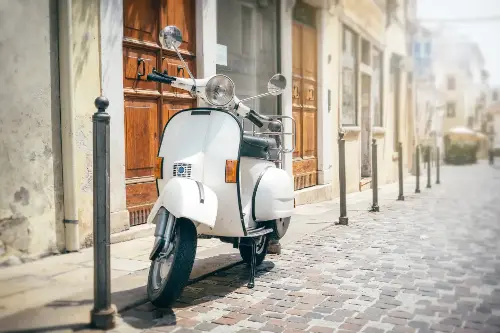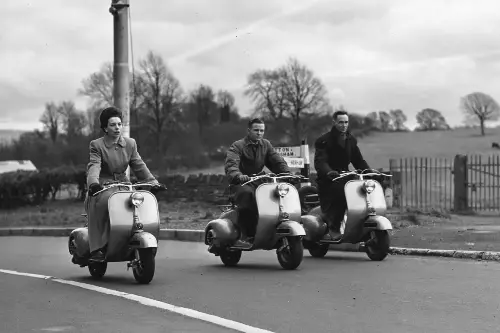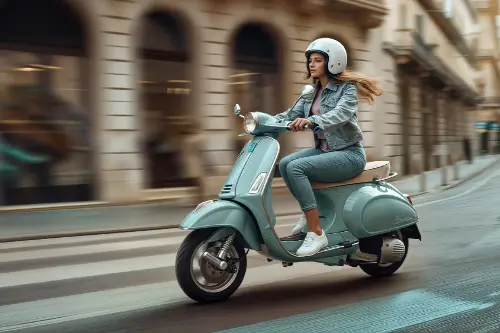A Whirl Through History: The Birth of Vespa

In the immediate post-war years, when resources were scarce and economies across Europe were rebuilding, an iconic design emerged from Italy that would not only become a symbol of freedom and rebirth but would also weave itself into the very fabric of fashion. The Vespa, born in 1946 from the ingenuity of Enrico Piaggio and the design prowess of Corradino D’Ascanio, was more than just a mode of transport; it was a beacon of hope in a grey landscape. With its sleek lines, shiny exterior, and ease of use, the Vespa was designed to bring mobility to the masses while embracing a style that transcended the mundane.
The Vespa, meaning 'wasp' in Italian, due to its distinctive buzzing sound and slender 'waist', quickly captured the imagination of post-war Europe. It offered an affordable and practical solution to transportation that greatly appealed to a continent on the move. But the Vespa’s journey was just beginning, as it was about to ride down the road of global fashion and iconography.
Embracing Design Innovation
From the outset, design was at the forefront of Vespa’s philosophy. D'Ascanio, an aeronautical engineer by trade, introduced revolutionary concepts with this scooter. Vespas featured a unique front fork design, similar to an aircraft’s landing gear, that provided a smoother ride and made tyre-changing easier. The engine was ingeniously placed beside the rear wheel, creating a clean, enclosed compartment that protected riders from oil and dirt, something that appealed to the style-conscious.
Such design choices made Vespas not only functional but also aesthetic marvels—a sleek vehicle with a unibody steel frame that was, incidentally, a first in motorcycle history. This wasn’t just a machine; it was the epitome of Italian design—minimalist yet distinctly elegant. Vespa’s evocative shape and ease of use attracted a broader audience, including women, and soon it was a common sight in the bustling streets of Europe and beyond.
Riding the Pop Culture Wave

The 1950s and 60s saw Vespa leap from commuter scooter to cultural sensation, featuring in films such as 'Roman Holiday' where Audrey Hepburn and Gregory Peck added a dash of romance to its image. This exposure fostered the Vespa’s association with glamour, style, and adventure, aligning it closely with the 'Dolce Vita'—the sweet life that post-war society yearned for. This alignment with cinema solidified its place as a cultural icon.
The 'mod' movement in 1960s Britain adopted the Vespa for its clean lines and modern look, further establishing the scooter as a style icon. Mods often decked their Vespas out with colourful accessories and an array of mirrors, integral to the visual language of the subculture. Through films, music, and media, Vespa had successfully transitioned from transportation to a symbol of fashion, independence, and an aspirational lifestyle.
Expanding Influences in Fashion and Beyond
Functionality met high fashion as designers began to draw inspiration from the Vespa's aesthetic appeal. On international fashion runways, models paraded attire that complemented the scooter’s chic reputation, reflecting a synergy between modern transport and contemporary fashion. The Vespa not only served as a backdrop but often as a muse to the fashion industry, mirroring and influencing designs with its clean, fluid lines and modern spirit.
Moreover, the Vespa’s fashion influence extends to accessories. From helmets that embody the same sleek design principles to jackets and apparel that exude the scooter's charm, Vespa has spawned a whole fashion niche in the biking world, extending its reach considerably beyond transportation.
A Legacy That Breathes Style

Today, the Vespa remains more than just a scooter—it has become a representation of style, an accessory to one’s personal image, and a testament to Italian craftsmanship. Modern versions of the Vespa continue to respect the original design ethos while integrating contemporary technology, thereby remaining at the intersection of functionality and fashion.
Across street style blogs, Instagram feeds, and in urban centres around the globe, Vespas continue to be photographed, shared, and celebrated. With initiatives like Vespa art, where artists and designers re-imagine Vespas in their own vision, to limited edition collaborations with high-end fashion brands, it’s clear that Vespa’s style icon status is not just intact but is revving as vivaciously as ever.
A Journey into the Future
The future looks just as bright for Vespa. As environmentally conscious choices become ever more critical, Vespa has stepped into the eco-friendly arena with electric models that offer a green alternative without compromising on style. As we dash towards a future where sustainability is paramount, Vespa remains poised to continue its legacy not just as a nod to fashion but also as a companion to the environmentally-minded modernist.
In a world where trends come and go with increasing rapidity, the Vespa’s cultural and stylistic influence for over seven decades is a narrative of exceptional endurance. Its unique blend of functionality with fashion and its remarkable history of adapting to the changing tides not only transformed Vespa into a global style icon but also cemented its place in the annals of design innovation. Riding in style has never been more emblematic of personal expression and timelessness than when one is seated upon a Vespa, and as history has shown, few modes of transport can claim to have journeyed quite so elegantly through the fabric of modern culture.
